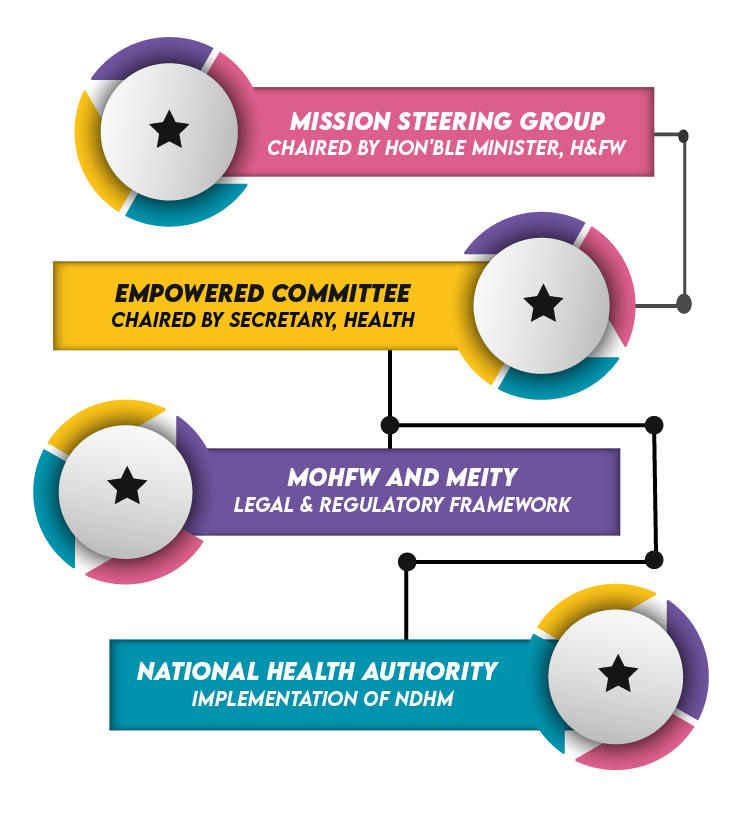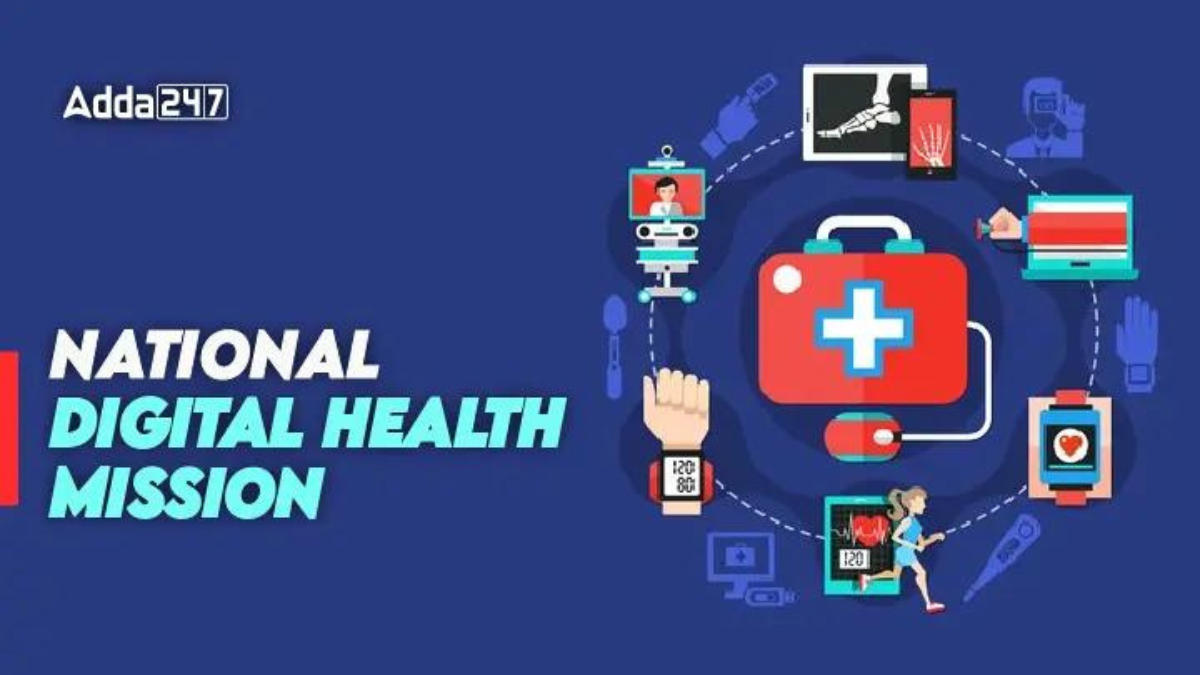Table of Contents
As an integral part of the National Digital Health Blueprint unveiled in 2019, Prime Minister Narendra Modi launched the National Digital Health Mission On India’s 74th Independence Day, August 15, 2020. The National Digital Health Mission will implement the core and common digital building blocks required for healthcare and make them accessible as digital public goods to both the public and private ecosystems.
For the convenience of aspirants, we have provided details on the National Digital Health Mission, its background, implementing agency, vision, and aim of the National Digital Health Mission, salient features, components, benefits and challenges, expected outcomes, suggestions, and the way forward that is important for the UPSC IAS Exam.
The National Health Policy (NHP) 2017 has the following goal:
- The attainment of the highest possible level of health and well-being for all ages, through a preventive and promotive health care orientation in all developmental policies, and universal access to good quality health care services without anyone having to face financial hardship as a consequence.
- In a follow-up of the NHP’s specific goals for adopting digital technologies, the Ministry of Health and Family Welfare constituted a committee headed by Shri J. Satyanarayana to develop an implementation framework for the National Health Stack. This committee produced the National Digital Health Blueprint (NDHB), laying out the building blocks and an action plan to comprehensively and holistically implement digital health.
- Taking forward the NDHB, this document describes the broad context, rationale, scope, and implementation arrangements for a digital ecosystem for healthcare services across the country. Since the implementation is envisioned to be in a mission mode, the initiative is referred to as the National Digital Health Mission (NDHM).
National Health Policy 2017
Through this NDHM policy all the citizen’s good health care in an assured manner. The NHP 2017 strives to tackle the rising challenges arising from the ever-changing Socio-Economic, Technological, and Epidemiological situations.
Features of the Policy
In the below section, you will get to learn about the different features of the National Digital Health Mission. It is recommended you read the following points.
- Incremental assurance-based approach.
- It signifies a major change towards a comprehensive fundamental health care package.
- It envisages the provision of higher packages of assured extensive primary health care through the ‘Health and Wellness Centers.’
- In all public hospitals, it proposes free medication, diagnostics, and emergency and essential health care services to give access and fiscal protection.
- It also envisages the inclusion of AYUSH systems encompassing cross referrals, co-location, and integral practices across systems of medicine.
Health Expenditure: The policy proposes raising public health spending to 2.5% of the GDP by 2025.
Implementation of the Mission
NDHM is a collaborative initiative between many ministries/departments. Given the inter-linkages and comprehensiveness of the Mission, the following governance structure is proposed for the implementation of NDHM

As per the National Digital Health Blueprint, the mission will keep two separate arms – one for regulation and the other for implementation and operational management.
Vision of National Digital Health Mission
In order to support universal health coverage in an effective, accessible, inclusive, affordable, timely, and safe manner, a national digital health ecosystem must be established. This ecosystem must provide a wide range of data, information, and infrastructure services while appropriately utilizing open, interoperable, standards-based digital systems and guaranteeing the security, confidentiality, and privacy of personal health information.
Aim of the National Digital Health Mission
1. To establish state-of-the-art digital health systems, manage the core digital health data, and the infrastructure required for its seamless exchange;
2. To establish registries at an appropriate level to create a single source of truth for clinical establishments, healthcare professionals, health workers, drugs, and pharmacies
3. To enforce the adoption of open standards by all national digital health stakeholders
4. To create a system of personal health records, based on international standards, easily accessible to individuals healthcare professionals, and service providers, based on
individual’s informed consent
5. To promote the development of enterprise-class health application systems with a special focus on achieving the Sustainable Development Goals for health;
6. To adopt the best principles of cooperative federalism while working with the States and Union Territories for the realization of the vision
7. To ensure that the healthcare institutions and professionals in the private sector participate actively with public health authorities in the building of the NDHM, through a combination of prescription and promotion
8. To ensure national portability in the provision of health services
9. To promote the use of clinical decision support (CDS) systems by health professionals and practitioners
10. To promote better management of the health sector by leveraging health data analytics and medical research.
Components of the National Digital Health Mission
- Health ID- The Health ID will uniquely identify people, authenticate them, and thread their health records with their consent across several systems and stakeholders.
- Electronic Medical Records (EMR)- It is a digital edition of a patient’s record which holds the patient’s medical and treatment record from a SINGLE health care facility.
- Health Facility Registry (HFR)- Registering in the Health Facility Registry will authorize them to get connected to India’s digital health ecosystem.
- Healthcare Professionals Registry (HPR)- It is a comprehensive repository of all healthcare professionals delivering healthcare services across present-day and conventional systems of medicine.
- NDHM Health Records (PHR – Personal Health Record)- A PHR is a computerized record of health-related information of an individual, the tasks that are supported by a Personal Health Record (PHR) system will permit an individual to manage data about his or her health.
Phased Implementation Methodology
The Mission will follow the approach of ‘Think Big, Start Small, Scale Fast’. This will enable a fast-paced and agile implementation and provide learning. The implementation of NDHM will occur in 3 phases.
Phase 1 will comprise a pilot in the following areas with a total of 5 services (+2 services with regulatory clearance)
1. Andaman & Nicobar Islands
2. Chandigarh
3. Dadra & Nagar Haveli and Daman & Diu
4. Lakshadweep
5. Ladakh
6. Puducherry
Phase 2 will be taking forward the pilot in additional States and expanding the service bouquet.
Phase 3 will target nationwide roll-out, operationalizing and converging with all health schemes across India along with promotion, onboarding, and acceptance of NDHM across the country.
The Expected Outcomes of the Mission
The various artifacts and deliverables of NDHM are designed and developed in such a manner as to enable progress toward the following outcomes:
1. All individuals will be able to conveniently access their health records
2. Leveraging longitudinal health record data, more people-centered care, reducing the occurrence of repeated diagnostic tests unless warranted
3. Individuals will be able to aggregate their health data in a single application (PHR), although multiple agencies/ departments/service providers are involved where the data is generated
4. NDHM will assure the continuum of care for individuals, across primary, secondary, and tertiary levels and public and private service providers
5. A framework for a Unified Communication Centre will be prepared to facilitate services and outreach
6. NDHM will support national portability for healthcare services
7. Privacy of personal and health data, and informed consent‐based access to PHRs will be an inviolable norm, with which all systems and stakeholders will comply
8. NDHM will be aligned to the SDGs related to health
9. NDHM will enable evidence‐based interventions in public health; and
10. Above all, the analytical capabilities of NDHM will support data‐driven decision-making and policy analysis.
Way forward for NDHM
NDHM will initially be incubated at the National Health Authority. Subsequently, after learning of Phase 1, the way forward for NDHM may be evaluated and a suitable model will be selected.
The following are probable options for operating NDHM:
1. Continuation at NHA: The Mission may continue to be operated by NHA, in which case the separate Division created by NHA for implementation of the Mission during the incubation period may become permanent. This will be independent from
other operations of NHA.
2. Another entity related to NHA: A new functionally and financially autonomous entity under NHA may be created, to take care of overall operationalization and management of NDHM. This will be similar to the NPCI, created to manage UPI. The Mission may be transferred from an internal division of NHA to this newly created entity, along with the core team created during the incubation period, with expansions/replacements as required. NHA may continue acting as a guiding organization to this new entity.
3. Distinct entity not linked to NHA: NDHM may be transferred to a new entity as finalized by the Mission Steering Group. Accordingly, new teams may take of all products and teams may be transferred, including overall operations, stakeholder
engagement, administration, and finance.



 TSPSC Group 1 Question Paper 2024, Downl...
TSPSC Group 1 Question Paper 2024, Downl...
 TSPSC Group 1 Answer key 2024 Out, Downl...
TSPSC Group 1 Answer key 2024 Out, Downl...
 UPSC Prelims 2024 Question Paper, Downlo...
UPSC Prelims 2024 Question Paper, Downlo...




